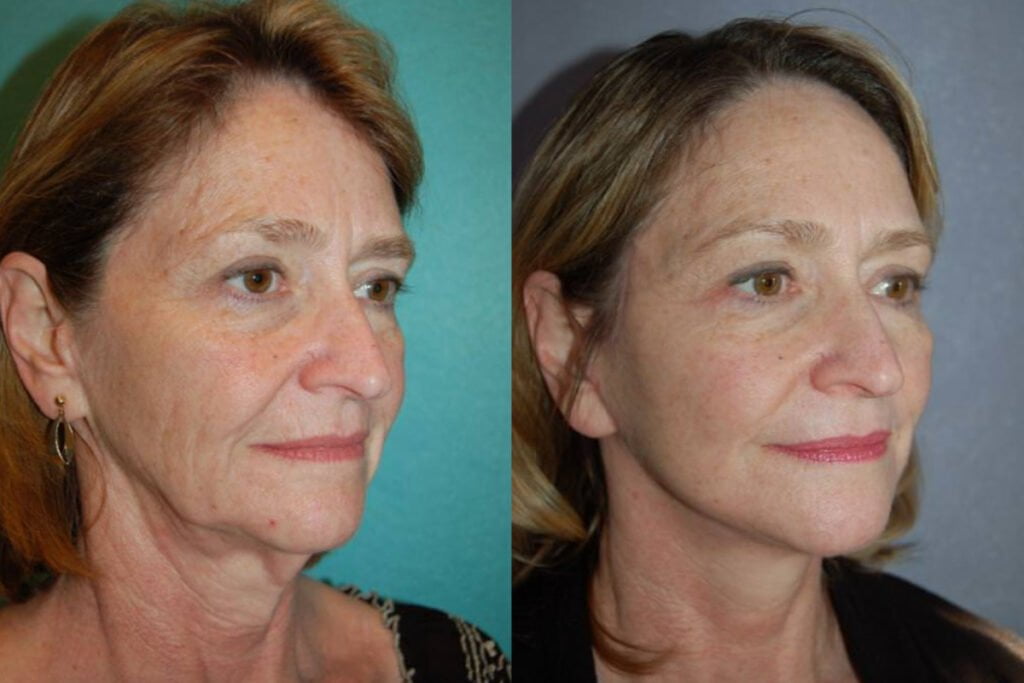Yes, You Can Have a Facelift Under Local Anesthesia

Facelifts can be incredibly transformative, yet the thought of undergoing elective surgery with general anesthesia can be daunting. Dr. Mark Mandell-Brown and Dr. Gina Maccarone understand these concerns and are here to reassure you that, yes—you can get a facelift under local anesthesia with IV sedation! This can make for a more streamlined, comfortable recovery, in addition to helping you avoid any concerns about being completely sedated.
How a facelift is performed under local anesthesia with sedation
Facelift surgery under local anesthesia begins with the application of local anesthetic injections (much like you have for dental procedures) to numb targeted areas of the face. Depending on your preferences and surgical plan, you will likely also have intravenous (IV) sedation to help you feel relaxed while remaining conscious; this is sometimes called “twilight anesthesia.”
This differs significantly from general anesthesia, in which you are completely asleep and unaware during the surgery. (And, while general anesthesia can have aftereffects like grogginess for up to 48 hours after surgery, IV sedation medications leave your system much faster.)
Choosing local anesthesia eliminates the “anesthesia hangover” and gets you back to normal activities more quickly.
During either process, your vital signs are closely monitored by an anesthesiologist or a nurse anesthetist to promote your safety. While each patient will have a unique surgical plan, the technical aspects of the procedure are generally the same: your cosmetic surgeon makes strategic incisions, often around the natural contours of the ears and in the hairline, to minimize visible scarring. With precision and artistry, your surgeon tightens underlying muscles and removes excess fat before carefully repositioning the skin to create a more youthful and refreshed appearance.
Benefits of local anesthesia for facelifts
Many patients do not realize that avoiding general anesthesia promotes a quicker recovery in two major ways—by reducing bruising and helping you move around more quickly.
Less bruising
General anesthesia can result in more bruising due to its effects on your blood vessels, and thus local anesthesia with IV sedation minimizes post-surgical bruising. We complement this with other techniques to reduce bruising and swelling so that you can get out and enjoy your results more quickly without hiding under makeup.
Quicker return to “normal”
Without the groggy, disorienting after effects of general anesthesia, patients typically return to their normal activities sooner than you might expect (usually about 1-2 weeks). We tell all patients to be sure to ambulate (this means move around) on the day after surgery to promote healthy circulation. This is easier for patients who had local anesthetic, and helps them to feel like themselves again more quickly.
Peace of mind
Another benefit for many patients is that avoiding general anesthesia provides an extra sense of safety, as the procedure inherently carries fewer risks: the targeted approach of local anesthesia reduces the chance of complications during and after surgery. Still, a facelift is a serious surgical procedure, and we will go over all facelift risks with you in advance to help you make an informed choice. Many patients will simply prefer to be completely asleep during their surgery.

- Procedures Often Offered with Local Anesthesia
- Procedures Often Offered with General Anesthesia
- Facelift and neck lift
- Eyelid lift
- Brow lift
- Otoplasty (Ear surgery)
- Mini liposuction
- Earlobe repair
- Brazilian butt lift
- Labiaplasty
- Facelift and neck lift
- Rhinoplasty
- Breast augmentation
- Breast lift
- Tummy tuck
- Mommy makeover
- Large-volume liposuction
- Body lift
- Arm lift
- Thigh lift
- Brazilian butt lift
Is an awake facelift right for me?
Ideal candidates for a facelift under local anesthesia are those in good health who have realistic expectations for surgical outcomes, and who prefer to avoid general anesthesia for personal or medical reasons, such as certain health conditions.
Choosing the right type of anesthesia is a critical decision that should only be made after a thorough consultation with your surgeon. In a consultation here at our plastic surgery center, Dr. Mark Mandell-Brown or Dr. Gina Maccarone will discuss your aesthetic goals, review your medical history, and determine the most appropriate approach to meet your needs. We are committed to help you feel informed, comfortable, and excited about your journey toward a rejuvenated appearance!
Schedule your consultation today by calling 513-984-4700 or filling out the form below.


